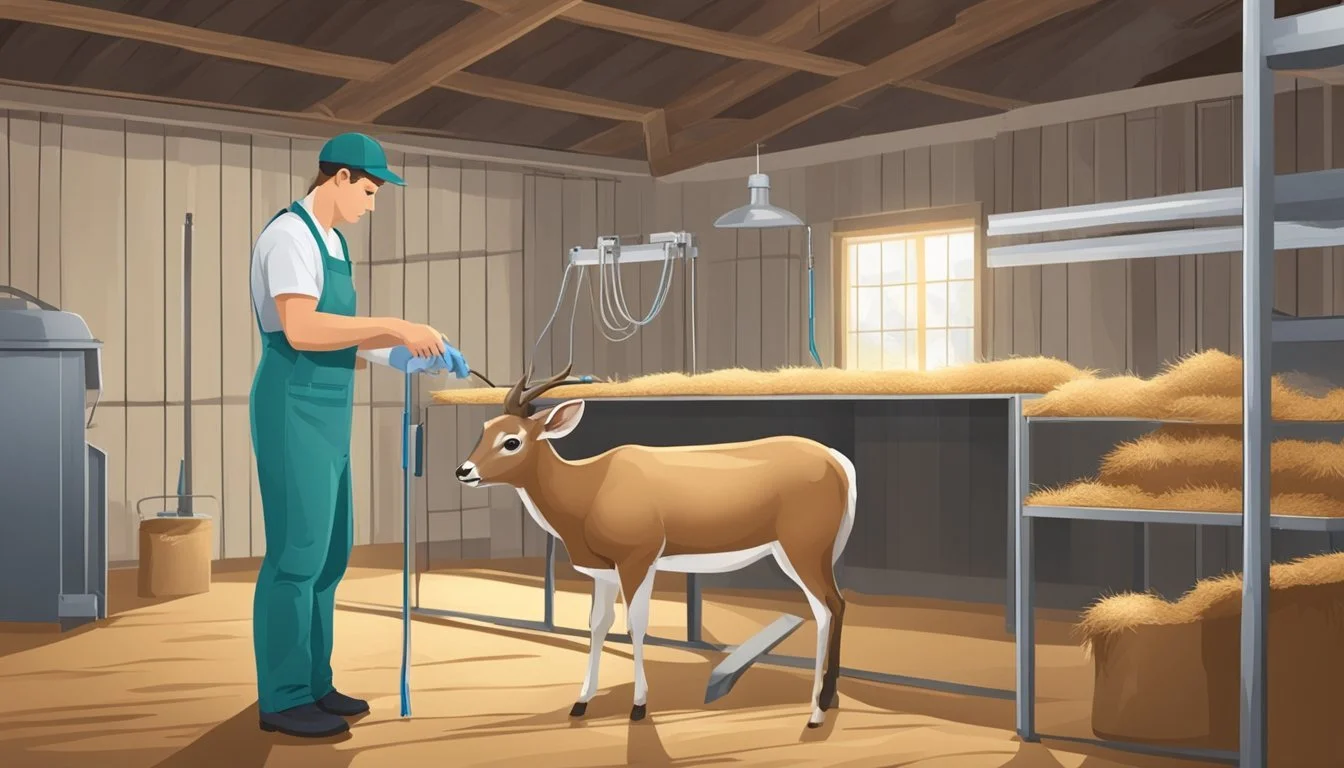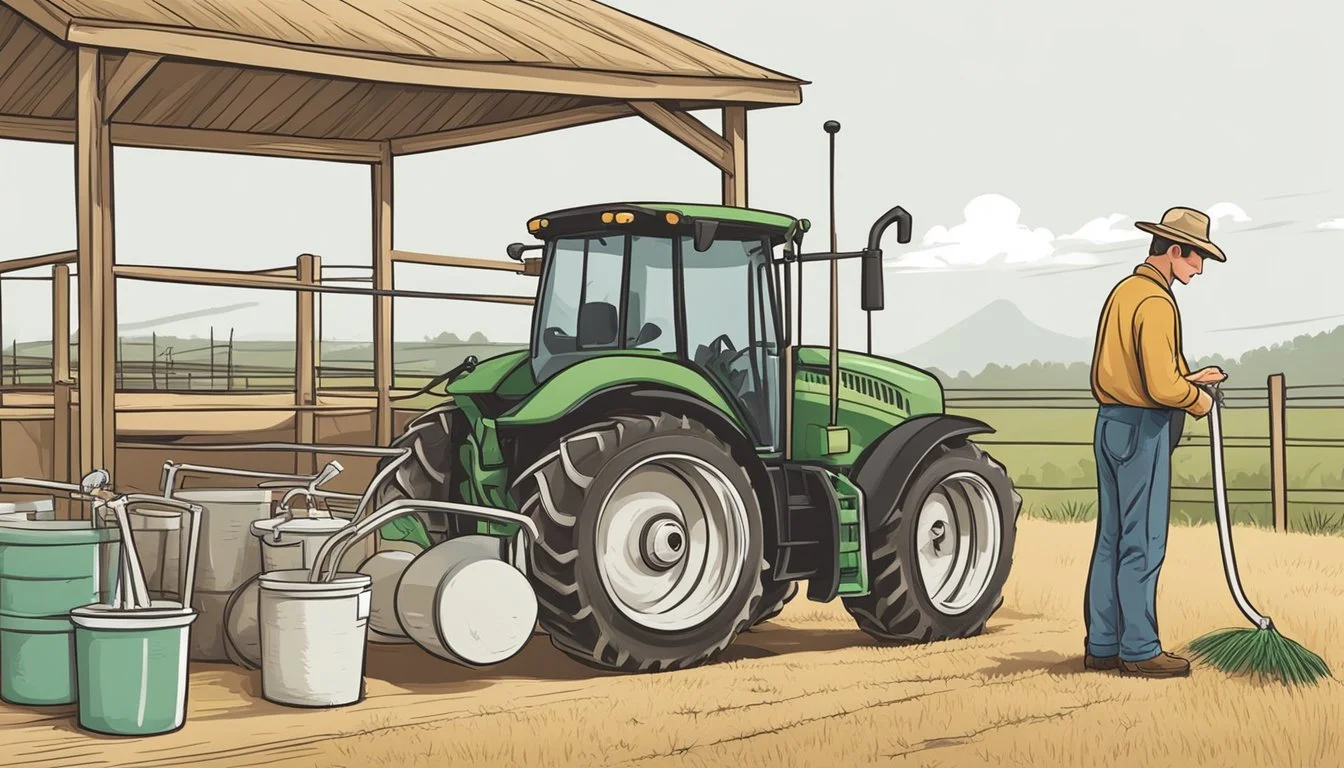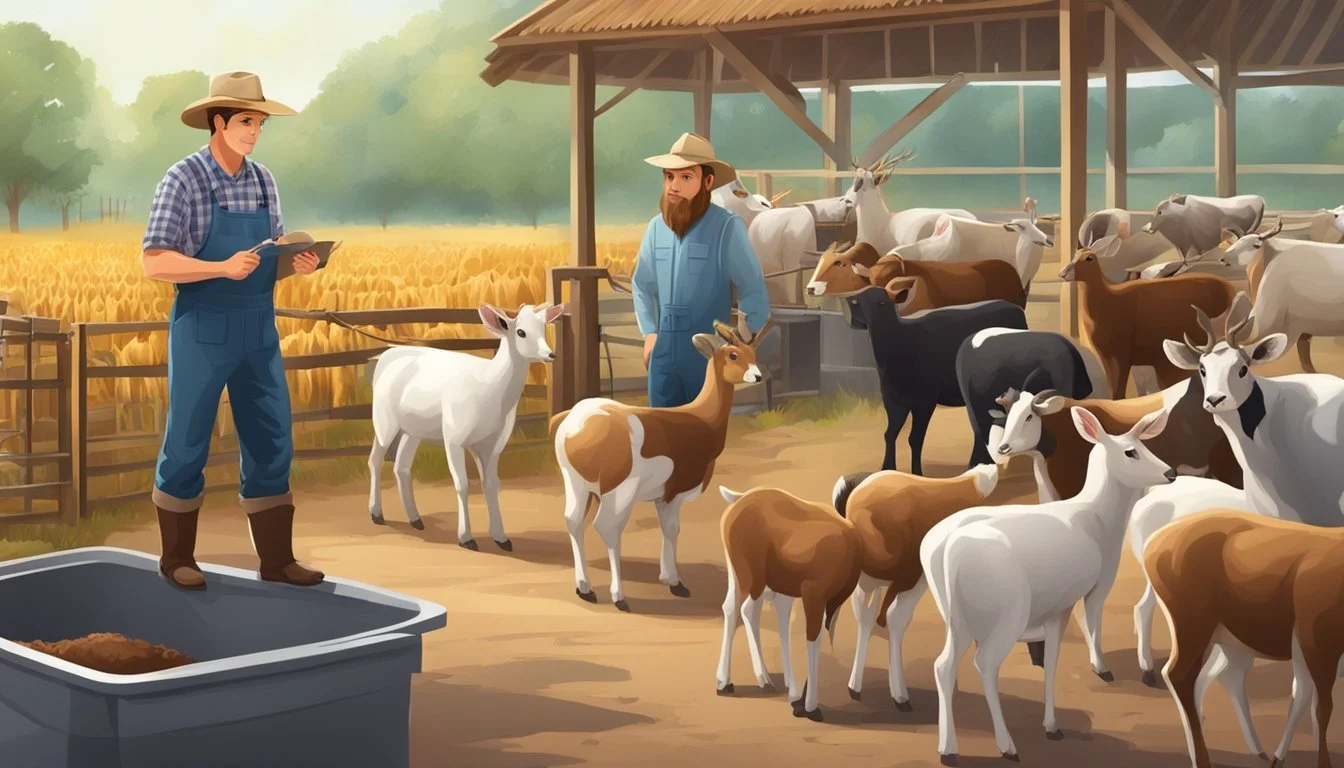Should I Keep a Buck or Use Artificial Insemination?
Deciding on Livestock Breeding Methods
When managing a livestock farm, deciding between natural breeding with a buck and employing artificial insemination (AI) is a significant choice. Each method has its distinct advantages and considerations. Keeping a buck on the farm enables natural breeding processes and may seem more straightforward; the buck lives on the premises and can mate with does as they come into heat. This method allows for natural selection and behaviors, but it also necessitates suitable housing, feed, and management of the buck, which can be costly and labor-intensive.
On the other hand, artificial insemination offers several benefits that can outweigh keeping a buck for natural breeding. Through AI, a single ejaculate can serve many cows, allowing farmers to utilize superior genetics more widely without the cost of maintaining multiple bucks. AI can also prevent the spread of diseases that can be transmitted through natural breeding. However, it requires precise timing and handling, as well as the need for storage facilities for frozen semen. The choice between keeping a buck or utilizing AI hinges on multiple factors, including farm size, breeding goals, and resource availability.
Understanding Artificial Insemination
Artificial insemination (AI) is a livestock breeding technology that introduces semen into a female's reproductive tract without natural mating. This technique is instrumental in the genetic improvement of herds and offers distinct advantages over traditional breeding methods.
Basics of Artificial Insemination
Artificial insemination is a process where sperm is collected from a male animal, such as a buck or bull, and inserted into the female's reproductive system. Genetics play a crucial role in this method, enabling breeders to select for specific traits and rapidly improve the quality of their livestock. Typically, semen is collected, processed, and stored in semen straws, which are then kept cryopreserved in liquid nitrogen until needed.
Semen and Semen Handling
Handling semen correctly is critical for the success of artificial insemination. Frozen semen must be thawed at specific industry-standard temperatures, generally between 90ºF to 95ºF. The straw containing the semen should be thawed for exactly 40 seconds and used within 15 minutes after thawing — failing to do so can significantly reduce the sperm's viability. It's also recommended to use non-spermicidal lubricant during the insemination process to avoid damaging the sperm.
Advantages of Using Artificial Insemination
Cost-Effectiveness and Safety: AI eliminates the need for keeping a male animal for breeding, which can reduce feeding and maintenance costs. It can also reduce the risk of disease transmission and injury that might occur during natural mating processes.
Genetic Diversity and Improvement: A primary advantage of AI is the ability to utilize genetics from top-quality males without their physical presence. This allows for considerable gains in desirable traits across the herd and access to a broader gene pool.
Efficient Use of Semen: One ejaculate from a superior male can be extended to inseminate multiple females, which enhances the efficiency of the breeding process. A single bull's ejaculate can potentially service over 400 cows, a feat that would be implausible via natural servicing.
In summary, artificial insemination offers a controlled, safe, and efficient alternative to traditional breeding, maximizing genetic improvement and herd health. With proper semen handling and an understanding of the AI process, livestock producers can significantly benefit from this technology.
Examining Buck Keeping for Breeding
When it comes to breeding livestock, the decision to keep a buck is significant, impacting genetics, fertility, and the management of the breeding process.
The Role of a Buck in Breeding
A buck plays a pivotal role in the breeding process due to its ability to enhance genetic diversity within a herd. This diversity is crucial for the health and vitality of the livestock. Bucks provide fresh genetics to the population, and responsible management ensures the improvement of specific traits within the herd.
Benefits of Keeping a Buck
The advantages of keeping a buck for breeding extend beyond genetics. It allows for a more natural mating process, which can be less stressful for the animals involved. With a buck present, breeders have the opportunity for selective mating, choosing the best time and best match for breeding based on observable signs of heat and compatibility.
Natural Mating: A buck can detect estrus in does with more accuracy than the average farmer, leading to potentially higher fertility rates.
Immediate Breeding: There is no need for complex timing or the risk of spermicidal lubricant usage, unlike with artificial insemination.
Challenges Associated with Buck Keeping
However, there are challenges in keeping a buck that one must consider:
Space Requirements: Bucks require adequate space to avoid stress and maintain health, which can be a concern for smaller operations.
Behavioral Issues: They may exhibit aggressive or undesirable behaviors during the breeding season, necessitating careful management.
Health and Maintenance: Regular health checks are important to ensure the buck's fertility remains high. This includes breeding soundness exams and monitoring for diseases that could affect reproductive success.
Keeping a buck for breeding in a livestock operation requires a balanced consideration of its role, benefits, and the challenges that come with it. Each aspect needs careful thought to manage a successful and efficient breeding program.
Reproductive Health and Management
Making the appropriate decision between keeping a buck or using artificial insemination hinges on understanding the complexities of reproductive health and management. This decision impacts conception rate, fertility, and ultimately, the success of the breeding program.
Female Reproductive Anatomy
The female reproductive anatomy consists of several key structures: the vulva, vagina, cervix, uterus, oviducts, and ovaries. The uterus is made up of the uterine body and uterine horns, which are critical for the development of the fetus during pregnancy. The ovaries are the site of ovulation, where eggs are released and transported through the oviducts to meet sperm for potential conception.
Reproductive Tract Infections and Management
Reproductive tract infections can severely affect conception rates and overall herd fertility. Good reproductive health management includes regular screening and treatment of infections. Maintaining cleanliness during breeding and ensuring proper health of the reproductive tract, specifically the cervix and vagina, helps reduce the risk of such infections.
Breeding Season and Fertility Monitoring
Monitoring the breeding season involves understanding the estrous cycles of females. Tracking signs of estrus in heifers and mares helps in predicting ovulation, ensuring higher chances of successful conception. Regular fertility monitoring through methods like ultrasound or rectal palpation can aid in assessing the reproductive health of the uterus and ovaries, contributing to informed breeding decisions.
Estrous Synchronization and Hormonal Control
Estrous synchronization involves the use of hormones, such as progesterone, to regulate and synchronize the estrous cycle of a group of females. This method allows for timed artificial insemination, improving pregnancy rates and the efficiency of the breeding program. Effective hormonal control is conducive to better genetic selection, as it allows for breeding at optimal times with desirable sires.
Insemination Procedures and Techniques
Artificial insemination (AI) requires precision and a sanitary environment to promote successful conception rates. The procedures associated with AI range from semen handling to accurately depositing the semen within the reproductive tract of livestock such as goats and cattle.
Preparing for Artificial Insemination
Before attempting to inseminate, it's critical to ensure that all equipment is clean and ready for use. This includes the AI gun, scissors, and the AI catheter, which must be handled with a sterile technique to prevent infection and maximize the chances of success. Breeders should also have a liquid nitrogen tank for semen storage and a water bath for thawing semen to the correct temperature. To maintain reproductive performance, a genetic evaluation of the semen should be performed to ensure high-quality genetics are being introduced to the herd.
Insemination Technique and Process
Proper insemination technique is essential for achieving high conception rates. Operators must introduce the AI catheter with minimal pressure to avoid damage to the vaginal folds and the cartilage of the cervical opening. Once the AI gun reaches the cervix, navigating through the annular rings requires gentle but assertive movements. Semen deposition should occur at the precise location past the cervix for optimal chances of fertilization, a process often gauged by feeling the cervix through the rectum.
Post-Insemination Care and Follow-Up
After inseminating, the immediate care involves ensuring the animal's comfort and monitoring for any adverse reactions. Breeders should maintain detailed records for both the AI success and subsequent reproductive performance, including noting any changes in the animals' behavior or health status. Follow-up involves confirming pregnancy through appropriate tests to assess the effectiveness of the AI procedure.
Considerations for Implementing AI or Keeping a Buck
When deciding between artificial insemination (AI) and keeping a buck for breeding purposes, there are key aspects to consider including economic implications, management of labor and resources, and the genetic impact on the herd.
Economic Analysis of AI versus Buck Keeping
The cost-effectiveness of AI compared to maintaining a buck can vary. For dairy goats, where milk production is a priority, AI can introduce superior genetics cost-effectively, potentially leading to increased milk yields. However, AI requires the purchase of semen and may incur costs for the technician or veterinary fees. In contrast, buck keeping may seem economically advantageous, but it includes hidden costs associated with feed, shelter, and veterinary care. When considering heifers, the initial investment in AI might result in better long-term economic returns due to superior genetic traits aimed at improving litter size and productivity.
Artificial Insemination (AI)
Initial Costs: Semen purchase, technician fees
Ongoing Costs: Storage of semen, repeat inseminations
Potential Gains: Improved genetics, higher productivity
Buck Keeping
Initial Costs: Buck purchase price, transport
Ongoing Costs: Feed, shelter, health maintenance
Potential Gains: Immediate availability for breeding
Labor and Resource Management
AI requires skilled personnel who can carry out the procedure, while buck keeping necessitates daily labor for proper care. An AI program might streamline breeding logistics, reducing the manpower needed for mating and eliminating the need for buck housing and maintenance. However, it also means scheduling inseminations and managing semen inventory. Dairy goat operations might find that the trade-off between labor efficiency and resource allocation swings the decision in favor of AI when considering the culling of less productive animals and implementing superior genetics.
Genetic Considerations
AI gives dairy goat breeders the opportunity to access superior genetics from top bucks, which can dramatically improve qualities such as milk production and overall herd health. Such precision in selecting genetics allows breeders to plan and predict the herd’s genetic advancement. Conversely, keeping a buck offers less genetic diversity and can lead to inbreeding if not managed carefully. For breeders looking to maximize genetic progress or introduce new traits, AI may be more advantageous, especially when considering the elimination of undesirable traits through selective culling.
Health and Safety Regulations
When making a decision between keeping a buck or using artificial insemination (AI) for breeding livestock, health and safety regulations come to the forefront. Ensuring a sterile environment and proper handling of medical equipment are essential to prevent contamination and disease transmission.
Maintaining Sanitary Conditions
The cornerstone of AI is maintaining an environment free from bacteria to safeguard the reproductive health of the livestock. Sterile technique is paramount, which involves using sanitary techniques for all procedures. For instance, semen straws should be handled with clean, preferably sterile gloves, such as latex or nitrile, to prevent introducing contaminants into the urethra. A palpating arm used during the AI process must be thoroughly cleaned and disinfected between uses. Additionally, the use of non-spermicidal lubricant should be emphasized to avoid killing the sperm while maintaining a sanitary condition for insemination.
Handling Biohazards and Medical Supplies
Handling biohazards, such as semen straws and connective tissue, requires strict compliance with safety regulations. Medical supplies should be disposed of according to guidelines to prevent environmental contamination or the spread of disease. For example, after insemination, used nitrile gloves and any other materials that came into contact with reproductive tissues should be promptly and properly disposed. Additionally, hormones like equine chorionic gonadotropin, which may be used to synchronize estrus in livestock, should be handled with care, using appropriate spermicidal lubricant if needed. This meticulous attention to detail ensures the safety of both the livestock and the individuals performing the AI procedure.
Ethical and Regulatory Considerations
When deciding between keeping a buck for breeding or using artificial insemination (AI), there are significant ethical and regulatory considerations to take into account. These include the well-being of the animals involved and adherence to breeding practices that comply with established guidelines.
Animal Welfare Concerns
Animal welfare is a primary ethical consideration in the decision to employ AI or maintain a buck for natural breeding. The University of Missouri offers resources that suggest AI can reduce stress and injury that may result from natural mating processes. For instance, AI eliminates the risk of aggressive encounters between bucks and does, enhancing safety and improving overall fertility outcomes.
Pregnancy Rate: AI allows for controlled breeding, which may potentially increase pregnancy rates due to the precise timing of insemination.
Labor: Implementing AI requires skilled labor trained in ethical handling and insemination techniques to ensure animal well-being.
Moreover, ethical treatment during AI involves minimizing discomfort for the does, which translates to a commitment to using pain management and stress reduction strategies where applicable.
Breeding Regulations and Compliance
Breeding practices, whether natural or assisted, are subject to regulations that aim to protect genetic diversity and promote the health of the breed. Compliance with these breeding regulations is critical to maintaining the integrity of animal lineages and ensuring that the practices are ethically sound.
Registry: Breeders using AI must adhere to the specific guidelines provided by breed registries, which may require the use of semen from registered, genetically screened bucks.
Ethics: Both natural breeding and AI must be approached with a strong ethical framework to prevent any potential mistreatment of animals. It is essential for breeders to follow breeding regulations set by authoritative entities to ensure ethical standards are met. For example, certain methods of semen collection or insemination may be regulated to prevent harm to the animals.
In conclusion, whether opting for AI or the maintenance of a breeding buck, it is imperative to prioritize animal welfare and adhere to the regulations and ethical guidelines provided by breed registries and resources provided by academic institutions such as the University of Missouri. Decisions should be informed by the latest labor and fertility research as well as the most humane and compliant breeding practices.
Market Dynamics and Industry Trends
The livestock breeding landscape is being significantly shaped by technology and evolving market demands. Key dynamics include the adoption of artificial insemination for genetic improvement, market forces driving service offerings, and the overarching influence of genetics and artificial intelligence on livestock market trends.
Current Trends in Livestock Breeding Practices
Today's breeding practices are increasingly informed by scientific advancements and efficiency demands. Artificial insemination (AI) has become a standard in genetic selection processes, offering farmers the ability to enhance genetic diversity and improve herds without maintaining a buck. In sectors like dairy goats, this technique is preferred due to improved pregnancy rates and the control it provides over the genetic traits being passed on.
Market Demand for Artificial Insemination Services
The market for artificial insemination services is on an upward trajectory, particularly as buyers and sellers recognize its cost-effectiveness and high success rates. Driven by demand for greater fertility and productivity in livestock, AI services have become a growing industry, catering to those looking to optimize their breeding strategies while reducing the risks of disease transmission associated with natural breeding methods.
Impact of Genetics and AI on Livestock Markets
Genetics plays a crucial role in shaping the livestock markets, with a clear trend toward genetic optimization for traits such as milk yield or disease resistance. In addition to physical genetics, artificial intelligence (AI) has a growing presence, where data-driven insights aid in predicting optimal breeding pairs, forecasting market changes, and guiding genetic selection for upcoming breeding cycles. This integration of technology solidifies a transformative phase in how livestock markets operate, always aiming for the best outcomes in quality, productivity, and sustainability.
Case Studies and Expert Opinions
Case studies in livestock breeding practices and expert opinions indicate varying results when it comes to the choice between keeping a buck and using artificial insemination (AI) for genetic advancement and herd management.
Success Stories with AI
University of Missouri studies have shown the notable impact of AI on livestock genetic improvement. Carson Andersen, a renowned breeder, vouched for AI as it allows for more control over the genetic traits passed on, leading to superior progeny. Breeders using AI cite success stories where they have significantly increased milk production and improved the overall health of the herd without the need for a resident buck.
AI Success: Improvement in milk yield
Livestock: Cattle, sheep, goats
Breeding & Genetics: Precision in trait selection
Challenges and Solutions in Buck Keeping
Buck keeping poses its unique set of challenges, from the cost of feed to managing the buck's aggressive behavior during the rut. Solutions to make buck keeping more manageable include strict feeding regimes and adequate training to handle bucks safely. Some farmers prefer buck keeping for its natural breeding process, which can sometimes lead to unexpected, but favorable genetic combinations. However, AI's benefits in terms of eliminating the need for buck handling are compelling for many.
Challenge: Aggression management during rut
Solution: Implement training and controlled breeding environments
Conclusion
Deciding between keeping a buck for natural mating or opting for artificial insemination (AI) in livestock management is a decision that hinges on various factors including cost, genetic diversity, and operational efficiency.
Natural Mating:
Simplifies the breeding process
Requires physical upkeep of a buck
Can increase risk of disease transmission
Limits genetic diversity to the buck's own genes
Artificial Insemination:
Offers broader genetic diversity and superior genetics
Reduces risk of disease transmission
Incurs costs related to purchasing semen and the AI process
Requires technical proficiency or professional services
Evidence suggests that AI can have a positive impact on reproductive performance. Producers may consider this method for genetic improvement. Conversely, natural mating is straightforward but may not offer the same level of genetic progress.
In essence, if a producer values genetic diversity and aims to manage breeding with specific goals, AI is a compelling choice. For those looking for ease and tradition, or if managing small herds where cost is prohibitive, keeping a buck may be more reasonable. It is recommended each producer assesses their unique scenario, resources, and long-term objectives before making a decision.









